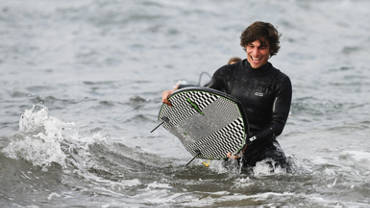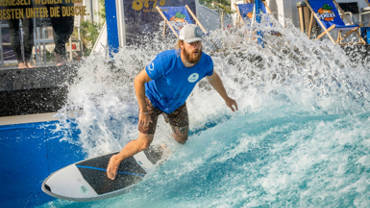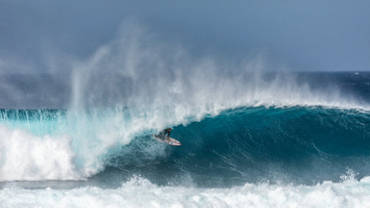With a few basic tips, you can "stand" in the wave for a few seconds from the very first session and slowly get used to the feeling of surfing a stationary wave. We talked to our experts and Blue Tomato team riders such as Patrick Rauter and have summarised the most important information for you here.
Where to start with riversurfing?
There are already several spots in the DACH region (Germany, Austria, Switzerland) and you can assume that there will be more riversurfing projects. Here is a small selection of well-known riversurfing spots:
Germany
- Langenfeld
- Eisbach Munich
- E2 Munich
- Floßlände Munich
- Dauerwelle Nuremberg
- Blackforestwave Pforzheim
- Leinewelle Hannover
Switzerland
- Thun Mühleschleuse
- Bremgarten
Austria
- Ebensee The Riverwave
- Almkanal Salzburg
- Pipeline Bad Ischl
Some of these spots are against payment, others are free of charge.
Please note, for example, that the famous Eisbach wave - practically THE birthplace of riversurfing - is not suitable for beginners. If you want to try out the sport in Munich, the best place to start is on the E2 (also in the English Garden) or at the Floßlände (Thalkirchen, near the campsite).
Flori Kummer, Munich Eisbach Local & Legend, shortly before Drop-in (photo: @julianankenbrand - Instagram)

If you are more of a surf newbie, the Almwelle in Salzburg is particularly suitable in Austria. Both the Almwelle and the waves in Munich are free of charge and the locals there are very helpful and friendly, as long as you respect surfing etiquette. More on this later.
What equipment do I need for riversurfing?
There are a number of brands that now produce boards suitable for riversurfing or even design surfboards specifically for riversurfing. Companies such as Lib Tech, have several boards in their range that not only perform superbly, but can also take a lot of hits. This is an advantage, as compared to a normal surfboard for the sea, boards for riversurfing often crash into concrete, wood or stone walls on the side and damage is therefore not uncommon. In plain language: the more stable your board, the fewer worries and annoying repairs. A unique manufacturing process and the special construction of Lib Tech surfboards make them particularly robust, durable and also more environmentally friendly.
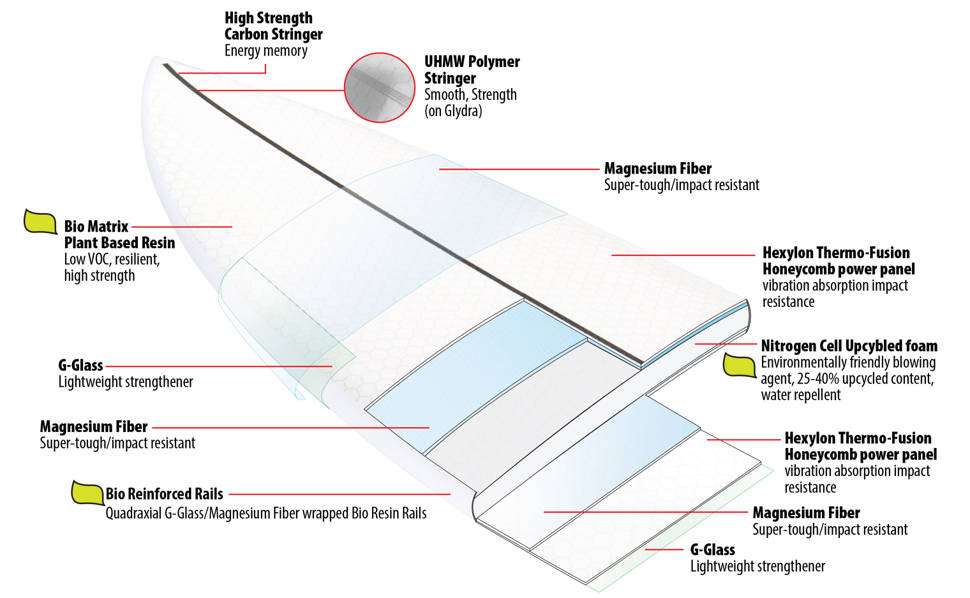
The choice is tough: In addition to the Whirlpool model developed specifically for riversurfing, further models such as the Puddle Jumper, RNF96 and the Hydra are also very popular in the riversurfing community.
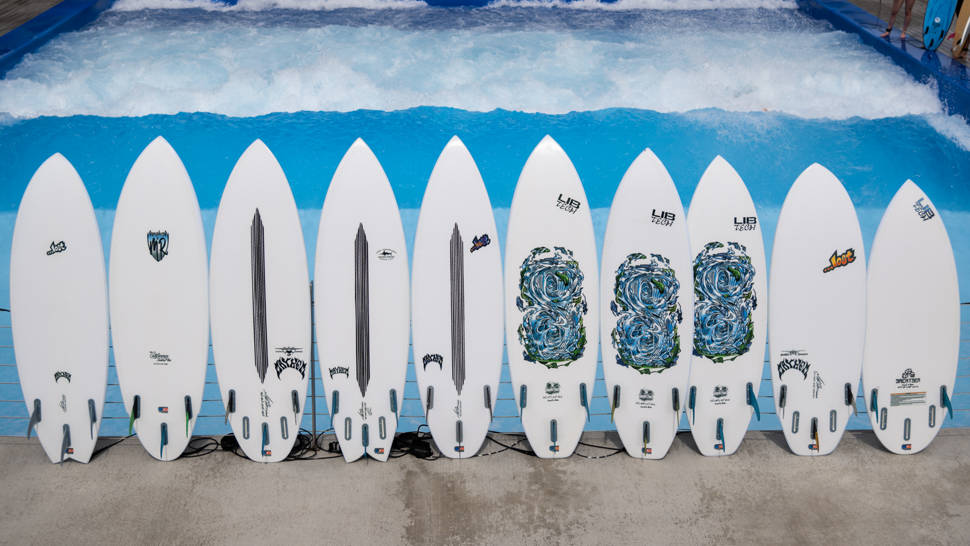
The Whirlpool from Lib Tech is the riversurf board par excellence. If you want to make very fast, radical turns, if you are thinking about fat sprays, ollies or even shove-its and 360s, then the Whirlpool is the board that will provide you with optimum support. The outline is relatively narrow, but thanks to the flat bottom in the centre of the board, or respectively under your front foot, it generates a lot of speed and very manoeuvrable handling. It is easy to control thanks to the concave trough under your front foot (similar to a skateboard). The board unfolds its full potential in rather powerful, fast waves such as The Riverwave or Eisbach - radical and super fun.
The RNF96‘ stands for Round Nose Fish and is a board that can also be ridden very well in smaller waves. It is forgiving and the V in the tail provides enough support in the turns - and you gain enough speed as a result. With the RNF, you can also lean really deep into the turns without drifting away.
Another favourite is the Lib Tech Hydra. Blue Tomato team rider Patrick Rauter: "Power and sufficient float are the two facets that first come to mind when I think of the Hydra. The wide shape makes it forgiving, but also more powerful to ride. If you tend to be taller and heavier and are looking for a board for small to medium waves, then the Hydra could be just right for you."
A few years ago, there was a real hype about the Puddle Jumper, which not only proves its versatility in the sea, but also in rivers. The Puddle Jumper was one of the first models from Lib Tech, which was favoured for riversurfing, especially in the smaller sizes, and is still very popular today.
Compared to the Hydra, the Puddle Jumper is a little more agile and therefore slightly less forgiving. Nevertheless, it is easy to control and, thanks to its slightly larger volume, can be ridden safely from rail to rail. The Puddle Jumper also makes it easy to perform fast turns and first attempts at ollies. Patrick Rauter would categorise the Puddle Jumper as a kind of hybrid between the Hydra and the Whirlpool. It is definitely also recommended for weaker waves and heavier riders. For sporty, ambitious riders with a certain amount of ambition, it is also a good choice as their first high-performance riversurf board.
Size and volume
Depending on the power and height of the wave, a board between 4'8" and 5'6" is recommended for adults. The shape should tend to be slightly wider, as width also means stability. A little rocker is recommended in any case, as this prevents you from peaking too easily in the front of the wave trough. In terms of board volume: For men over 80-90 kg, you can aim for just under 30 litres. Depending on your riding level and weight, you can of course also opt for slimmer and shorter shapes and less volume when choosing a board.
Fins
Be careful - some spots are real fin killers! Softer, cheaper fins are an advantage at the beginning. The vast majority of riversurfers use a twin setup. This means they use two fins and a maximum of one very small centre fin in the middle. As a rule, the larger the fin, the more stable the board is in the wave and the smaller the fin, the more agile/manoeuvrable the board becomes (but also more unstable).
Wetsuit
As riversurfing usually takes place in cold rivers, a wetsuit is definitely recommended. A long model with at least 3/2 thickness (i.e. 3 mm thick neoprene material on the torso and 2 mm thickness on the extremities) makes sense in most cases.
Booties
Beyond many river waves there are often stones on the bottom, which can lead to annoying cuts or other injuries to the feet. Booties - i.e. neoprene shoes - are therefore highly recommended. Apart from that, they also keep you nice and warm.
Leash
The leash is like the safety strap of your surfboard. A leash is indispensable for some river waves. There are also - especially for natural river waves - specially developed leashes for the hips, which can be opened very quickly in the extreme case of getting caught on branches or rocks. However, there are also river waves where you can or even should do without a leash. It's best to just ask the locals.
Your first steps on the board
Nose above water
A buddy can provide assistance at the beginning and hold the board at the nose. Then try to stand up and keep your balance with your back foot first and only then with your front foot.
On of the first steps: Holding the nose, at Almwelle Salzburg (photo: Patrick Rauter)
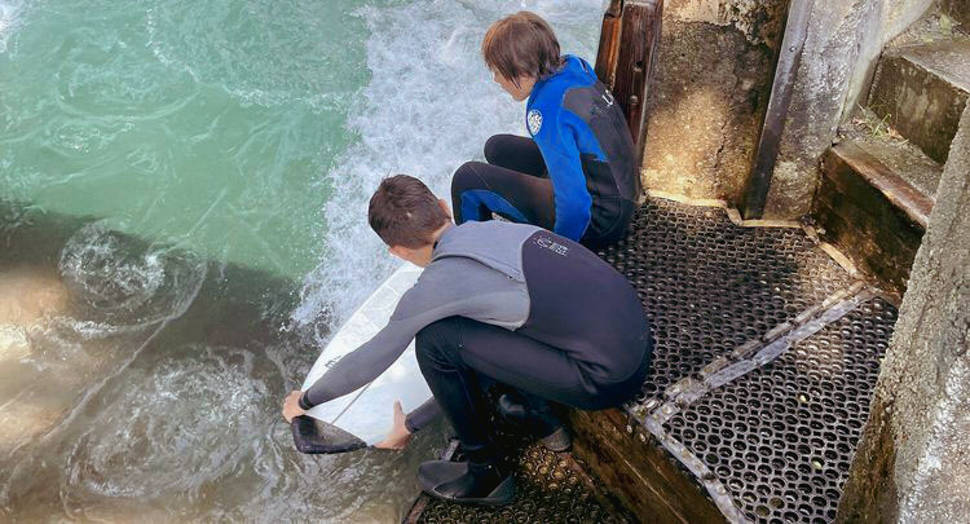
Helping hand
Now, of course, you want to surf off. A buddy or friendly locals can hold your hand during your first attempts so that you can slowly feel your way from the edge towards the centre of the wave.
On the board with a buddy holding your hand (Location: Almwelle Salzburg, photo: Patrick Rauter)
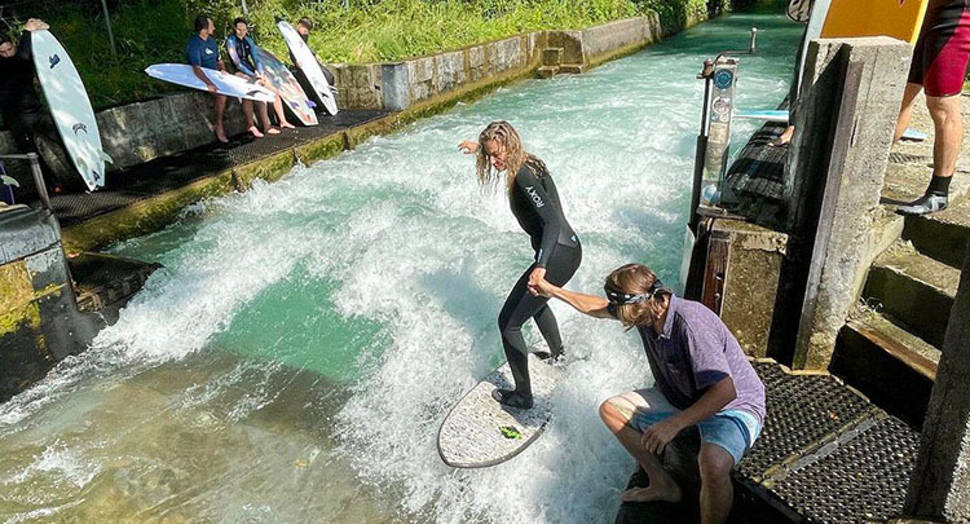
Floating point
The "floating point" is the area of the wave in which you are more or less standing still in the water on the board WITHOUT the nose peaking in at the front or being swept backwards over the wave. You could theoretically stay in this spot for a long time. Just by shifting your weight slightly forwards (towards the nose), you will be travelling in the direction of the wave trough. If you lean forwards a little too much, you will dive in with the nose.
Flori Kummer "searching for the floating point" (Location: Eisbach Munich, photo: @julianankenbrand - Instagram)

The very first turn
Once you have slowly approached from one side to the other and got a feel for the wave and the board - and the nose is still pointing forwards most of the time (= towards the wave trough) - it's time for the first real turns.
All turns in surfing are initiated by the head and shoulders, whereby this initiation of the first "turn" is initiated simply by looking at the opposite side of the wave.
Now you can start to ride the board back and forth with increasingly larger (and faster) swing movements from the upper body. If this is no longer a big challenge for you, then you are officially no longer a "kook" (in surf jargon for beginners).
...when surfing eventually looks like Flori Kummer on the Eisbach (photo: @julianankenbrand - Instagram)
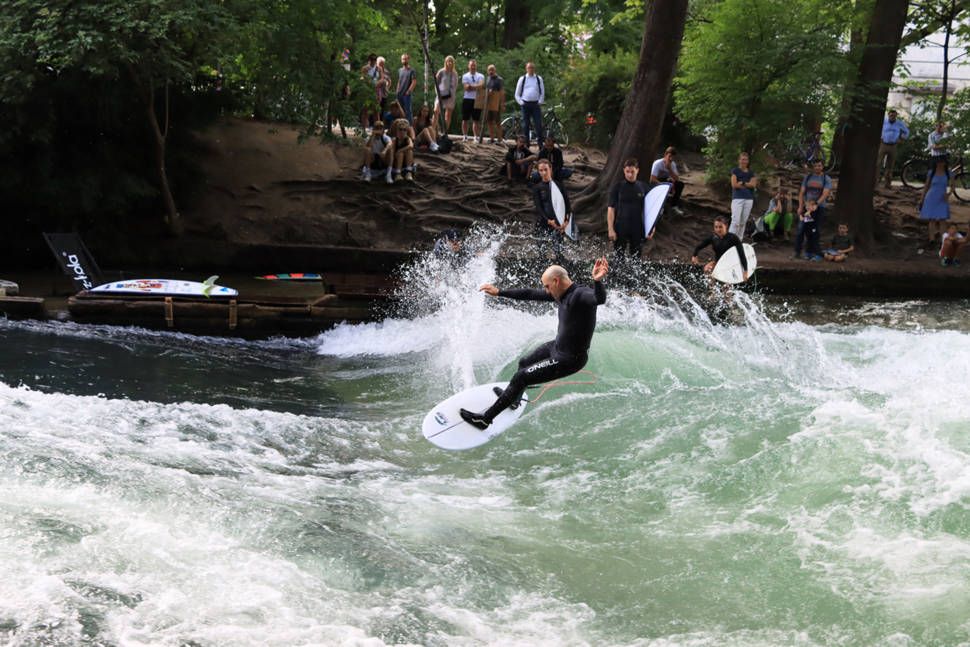
Safety Tips
Protect Ya' Face
If you are washed over the wave, emerge out of the water and don't know where your board is at that moment, ALWAYS hold your arms in front of your face. It is entirely possible that your board will be thrown out of the water behind the wave with some pressure and, in the worst case scenario, hit you on the head or face.
Protect your head and face with your hands and arms – Location Almwelle Salzburg (photo: Sandra Gellan)
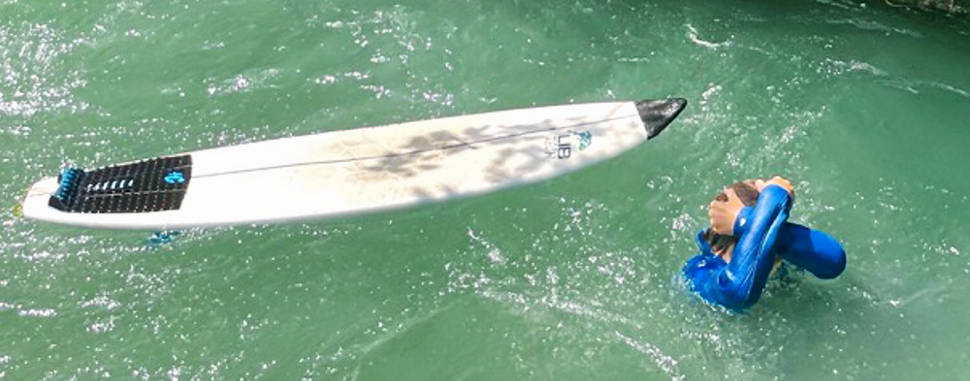
Nose tape
Stable but not indestructible: We recommend wrapping the nose of your board with commercially available tape before your first surf. Why? If a sharp nose crashes against a rock or wooden wall, this can leave unsightly damage. The tape gives your board additional protection.
Sandra inspects the tape job on the boards – Location Almwelle Salzburg (photo: Patrick Rauter)
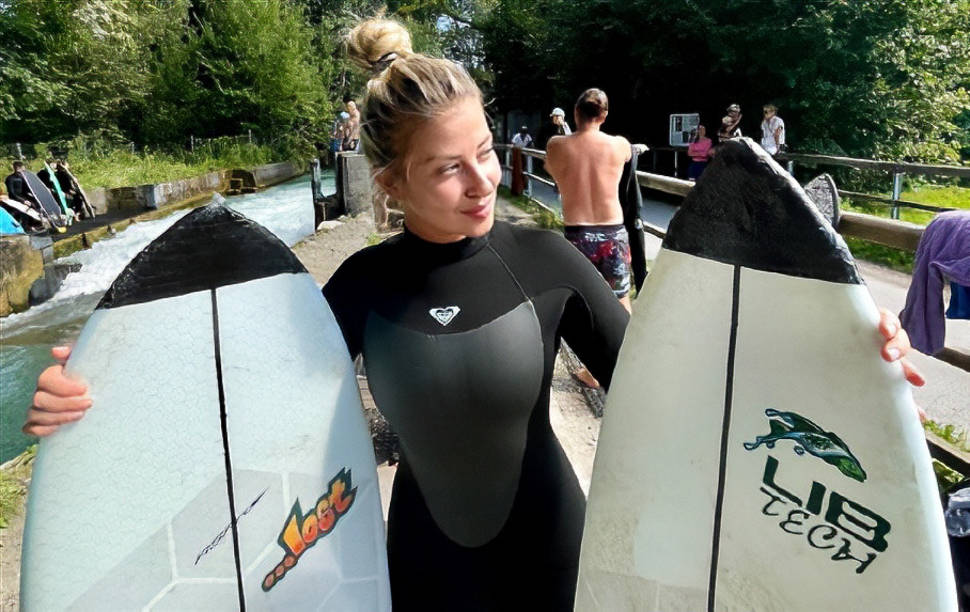
"No natural river waves for beginners"
There are of course various completely natural river waves for surfing almost everywhere on the world's rivers, but as a "bloody rookie" these are completely unsuitable for learning riversurfing. Apart from that, something like this can be very dangerous without local knowledge.
First Aid Kit
Minor injuries can happen quickly, so it is always a good idea to have a plaster or small bandage to hand.
Surf Etiquette
Respect the locals
It actually goes without saying: Respect the locals. Be friendly and modest - and you are guaranteed tips and tricks from the locals. Jumping the queue is an absolute no-go!
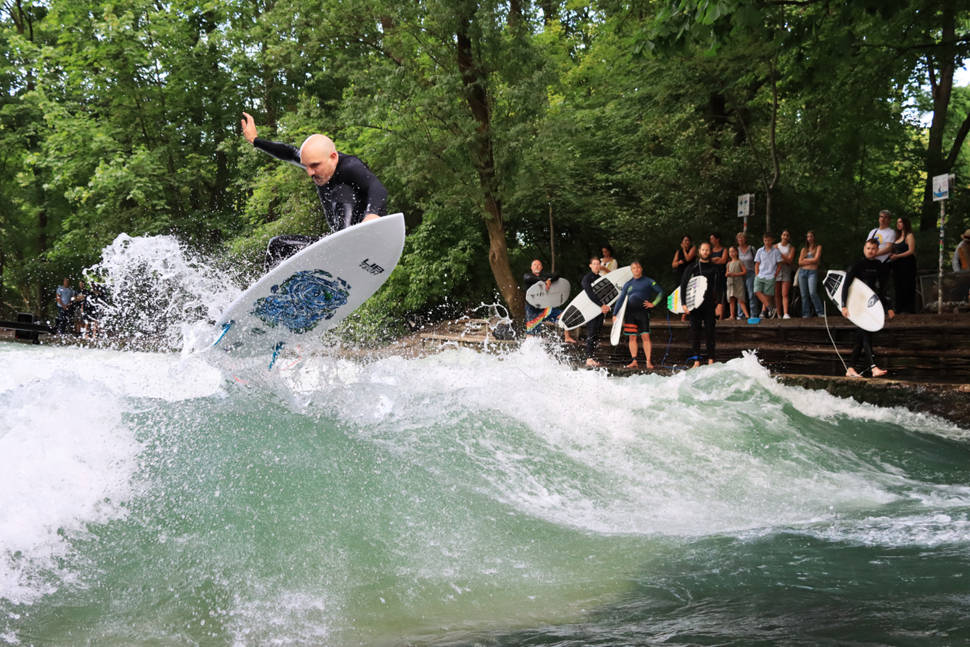
Knock, knock!
Tapping on the board means that someone has just mastered a great trick or learned something new. It's a way of expressing appreciation, i.e. giving the surfer "props". Even complete beginners can be tapped on the board when they manage to keep their balance a little longer for the first time. However, tapping on the board can also mean that someone has been in the wave for a relatively long time and should now slowly make room for the next rider.
The rule of thumb is to surf about 5-6 runs or just under 20 seconds and then go out or try something new and let the next rider have a go. Of course, this always depends on the number of people waiting in line. It's best to just be friendly and polite and check out how the others are doing first.
We hope that these tips have given you a first insight into riversurfing and wish you lots of fun ripping!
You can also find more information about the best surf equipment for you in our buyer's guides on surfboards and wetsuits.




